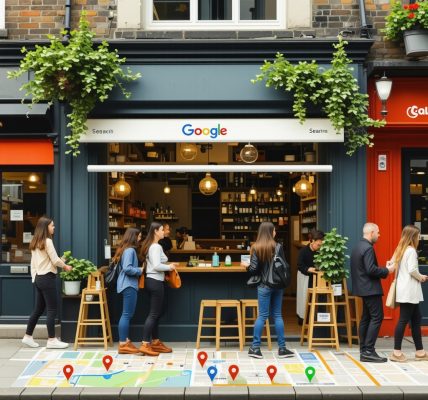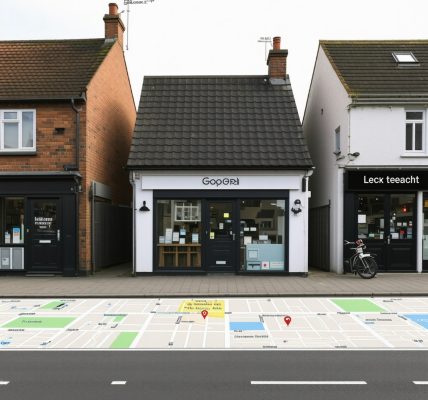Cracking the Code: Why the Local 3-Pack Is the Holy Grail for Small Businesses
In the fiercely competitive landscape of local search, securing a coveted spot in Google’s Local 3-Pack can transform a small business’s visibility and revenue overnight. This elusive trio of top local listings dominates the search results, capturing nearly 44% of clicks according to Moz’s Local Search CTR Study. But what are the proven strategies that small businesses can deploy in 2025 to crack this code and ascend to that prime real estate? Let’s dive into the nuanced tactics that go beyond basics and tap into the core of Google’s local ranking algorithms.
Hyperlocal SEO Mastery: Turning Neighborhood Nuances into Ranking Gold
Local 3-Pack SEO success starts with mastering hyperlocal optimization, which means tailoring your Google Business Profile and website content with ultra-specific neighborhood identifiers and long-tail keywords. Instead of broad keywords like “plumber in Chicago,” target “emergency plumbing services in Lincoln Park Chicago.” This leverages Google’s increasing ability to match searcher intent with precise geographic context, a tactic highlighted in the Hyperlocal SEO Guide. Incorporating these granular location signals into your business description, services, and posts helps Google confidently rank your business in the right local pack.
Rich Google Business Profile Optimization: Beyond the Basics
Many small businesses claim their Google Business Profile but neglect advanced optimization. Proven local 3-Pack SEO secrets in 2025 include strategically using keywords in your business description, choosing the most relevant and multiple categories, and regularly updating posts with offers or events. Also, photo optimization plays a surprisingly strong role: geotagging images and uploading high-quality pictures that reflect your business atmosphere can significantly boost engagement and rankings, as discussed in this expert guide. These layered signals feed Google’s AI to better understand and promote your location’s relevance and activity.
How Do Reviews Influence Small Business Ranking in the Local 3-Pack?
Reviews are the currency of trust in local SEO. Not only do positive reviews increase click-through rates, but Google’s ranking algorithm heavily weighs both the quantity and recency of reviews. Engaging with customers by responding promptly to reviews enhances your profile’s authority and signals active business management. Utilizing proven methods for generating reviews, like personalized follow-ups and incentivizing honest feedback without violating guidelines, can dramatically improve your Local 3-Pack chances. For an in-depth strategy, see Proven Methods for GMB Review Generation.
Leveraging Local Citations and Backlinks: The Overlooked Pillars
While many focus on the Google Business Profile, building authoritative local citations and backlinks remains a cornerstone of local SEO. Consistent NAP (Name, Address, Phone Number) citations across reputable directories and community sites amplify your business’s legitimacy. Moreover, earning backlinks from local newspapers, chambers of commerce, and niche-specific blogs signals trustworthiness and authority to Google. This synergy between citations and backlinks is critical for small businesses aiming to outpace competitors in the local 3-Pack.
Embrace Data-Driven GMB Insights for Continuous Growth
Google Business Profile Insights offer a treasure trove of data revealing how customers find and interact with your business. Regularly analyzing this data to identify high-performing keywords, popular times, and customer actions allows you to refine your local SEO strategy dynamically. Small businesses leveraging these insights can adapt quickly to changing search behaviors, ensuring sustained prominence in the Local 3-Pack. Learn practical approaches in Local Business Growth Strategies Using GMB Insights.
Ready to elevate your local SEO game and dominate the Google Local 3-Pack? Share your thoughts or questions below, and explore more expert strategies in our comprehensive guides to mastering Google Business SEO.
Why Consistency in NAP Data Is Your Secret Weapon
One of the lessons I’ve learned the hard way is that even the smallest inconsistencies in your Name, Address, and Phone number (NAP) across listings can confuse Google and undermine your local rankings. At first, I thought a slight variation like “St.” vs “Street” or adding an extra space in the phone number wouldn’t matter much. Boy, was I wrong. Ensuring that your NAP is absolutely consistent across every citation site, social media profile, and your website is foundational. It’s like telling Google, “Hey, this is the same trustworthy business everywhere you see it.” If you’re curious about mastering this aspect, check out the thorough advice on master local citation management to boost your Google SEO visibility.
The Power of Engaging Google Business Profile Posts
Another game-changer I gravitated towards was creating regular, engaging posts on my Google Business Profile. Instead of treating posts as just an obligation, I started sharing behind-the-scenes glimpses, limited-time offers, and even quick customer shout-outs. These posts not only keep my profile fresh but also invite interaction, which signals to Google that my business is active and relevant. Small businesses often overlook this, but it’s a subtle yet powerful way to stay top-of-mind with your audience and improve your local 3-Pack chances. If you want to dive deeper, explore effective GMB content updates that truly enhance local search rankings.
How Can Small Businesses Balance Authenticity with SEO Tactics in Their Profiles?
This question often pops up in my conversations with local business owners. Authenticity is crucial – people want to connect with real stories and genuine experiences, not canned marketing speak. Yet, SEO demands strategic keyword placement and structured data. From my journey, the key is blending both. Share your real stories but weave in relevant local keywords naturally, like mentioning your neighborhood or specific services. Use your Google Business description and posts to answer common questions your customers ask, which aligns well with SEO and builds trust simultaneously. This approach doesn’t feel forced and often leads to better engagement.
Leveraging Google’s Newer Features: Messaging and Q&A
Recently, I started using the messaging feature on my Google Business Profile, allowing customers to reach out directly. It’s been a fantastic way to capture leads and offer instant support. Plus, answering questions in the Q&A section not only helps prospective customers but also enriches your profile content. Google favors profiles with active engagement, and these features are relatively underused by many small businesses, so it’s an opportunity to stand out. For a detailed walkthrough on maximizing these tools, you might want to check GMB engagement strategies.
What Role Do Backlinks Play in Local 3-Pack Rankings in 2025?
Backlinks remain a crucial factor, especially local backlinks from credible sites. I often recommend small businesses focus on building relationships with local organizations, sponsoring community events, or contributing guest posts to neighborhood blogs. According to a recent study by SEMrush, high-quality backlinks can significantly boost local search rankings by enhancing domain authority and local relevance (SEMrush Local SEO Backlinks Guide). This strategy complements your Google Business Profile and citation efforts perfectly.
Have you experimented with any of these strategies? Or maybe you’ve discovered unique local SEO hacks that worked wonders for your business? I’d love to hear your story! Drop a comment below, share your experiences, or ask any questions – let’s learn and grow together.
Decoding Google’s E-A-T Principles: Elevating Your Local Business Authority
Google’s emphasis on Expertise, Authoritativeness, and Trustworthiness (E-A-T) has become pivotal in 2025, especially for local businesses vying for the Local 3-Pack. While traditionally associated with YMYL (Your Money Your Life) content, E-A-T influences local SEO by validating the credibility of your business online. To harness this, small businesses should showcase credentials, certifications, and affiliations prominently on their website and Google Business Profile. Moreover, actively participating in local industry events or forums and securing endorsements from recognized local authorities significantly bolsters your authoritativeness. Google’s algorithm intricately analyzes these signals, favoring businesses that demonstrate genuine expertise and community trust.
How Can Integrating Structured Data Markup Enhance Local 3-Pack Visibility?
Structured data, particularly Schema.org LocalBusiness markup, offers a sophisticated method to communicate your business details directly to search engines. By embedding structured data on your website, you provide Google with explicit information about your business name, address, phone number, service area, operating hours, and even customer reviews. This clarity facilitates enhanced search result features like rich snippets and knowledge panels, which amplify your local presence. Implementing structured data correctly reduces ambiguity and boosts your chances of being selected for the Local 3-Pack by signaling relevancy and accuracy.
However, it’s crucial that markup is precise and regularly audited to avoid errors that can negatively impact rankings. Tools like Google’s Rich Results Test and Schema Markup Validator can help maintain your structured data health.
Harnessing Behavioral Analytics: User Interaction as a Ranking Catalyst
Beyond traditional SEO factors, Google increasingly leverages behavioral metrics such as click-through rates (CTR), bounce rates, and mobile user engagement to refine local rankings. Small businesses that optimize their Google Business profiles to encourage meaningful interactions — for example, through compelling calls-to-action, streamlined contact options, and engaging multimedia — can indirectly influence these behavioral signals.
Moreover, tailoring your website and Google Business Profile for mobile users ensures accessibility and smooth navigation. Considering that over 60% of local searches originate on mobile devices according to BrightLocal’s 2024 Local Consumer Review Survey, prioritizing mobile UX can lead to longer user sessions and increased conversions, further signaling to Google the relevance and quality of your business.
Advanced Reputation Management: Navigating Negative Reviews and Amplifying Positive Sentiment
While accumulating positive reviews is essential, managing negative feedback with tact and strategy can be equally transformative. Responding professionally to critical reviews not only mitigates potential damage but also demonstrates dedication to customer satisfaction. Leveraging sentiment analysis tools to monitor review trends allows businesses to identify common pain points and swiftly address systemic issues.
Innovative approaches include integrating customer feedback loops directly into your service process and publicly sharing improvement initiatives based on reviews. This transparent cycle fosters community trust and can enhance your Local 3-Pack ranking by signaling active engagement and reliability to Google’s algorithm.
Innovative Link-Building Tactics: Beyond Traditional Local Citations
Elevating your backlink profile in 2025 requires creativity and a community-first mindset. Consider co-hosting webinars or workshops with local partners, securing media mentions through compelling storytelling, and contributing expert commentary to local news outlets. These initiatives generate high-quality, contextually relevant backlinks that elevate your domain authority and local relevance.
Additionally, engaging in local sponsorships or participating in charitable events can organically produce backlinks from reputable sources, enriching your link profile with authentic endorsements. A recent study by Ahrefs Local SEO Report confirms that link diversity and relevance remain among the top factors influencing local search rankings.
Are you ready to integrate these advanced techniques into your local SEO strategy? Dive deeper into mastering E-A-T, structured data implementation, and cutting-edge reputation management by exploring our expert resources and detailed case studies.
Decoding Behavioral Signals: How User Engagement Drives Local 3-Pack Rankings
As Google’s algorithms evolve, they increasingly prioritize behavioral analytics to assess a business’s local relevance. Metrics such as click-through rate (CTR), dwell time, and repeat user interactions provide nuanced insights into consumer intent and satisfaction. For small businesses, optimizing these behavioral signals entails crafting compelling Google Business Profile content with clear calls-to-action, intuitive navigation, and engaging multimedia assets like videos or 360-degree virtual tours. Such enhancements not only captivate users but also reduce bounce rates, indirectly signaling to Google the high quality and relevance of your listing. Furthermore, integrating chatbots or instant messaging features can elevate user engagement, providing a seamless communication channel that enhances conversion potential.
Semantic SEO and Structured Data: Unlocking Rich Snippets to Outrank Competitors
Beyond basic Schema markup, semantic SEO techniques enable businesses to communicate context and relationships between entities to search engines with greater precision. Implementing advanced structured data types such as Review, Offer, and Event schemas can enrich your Google Business Profile and website listings. These enhancements facilitate the display of rich snippets, including star ratings, promotional deals, and upcoming events directly within search results, thereby increasing click appeal and user trust. Regular audits using tools like Google’s Rich Results Test ensure your markup is error-free and fully leveraged to maximize visibility.
What Are the Best Practices for Utilizing Behavioral Data to Refine Local SEO Strategies?
Expert practitioners emphasize a cyclical approach: continuously monitor behavioral metrics through Google Business Profile Insights and website analytics to identify content or features that yield high engagement. For example, if a particular promotional post or local event generates spikes in clicks and calls, amplify these initiatives and replicate their successful elements. Conversely, high bounce rates or low conversion signals warrant content reassessment or UX improvements. Employing A/B testing on offers, calls-to-action, and multimedia can further optimize user interaction and boost rankings. Integrating this data-driven methodology aligns SEO efforts with real customer behavior, fostering sustained Local 3-Pack prominence.
Authoritative Insights from Google’s Official Documentation
Google’s Structured Data for Local Businesses guide provides definitive recommendations on implementing and validating schema markup. It underscores the pivotal role of accurate, comprehensive structured data in enhancing search features like knowledge panels and local business carousels. Adhering to these standards not only improves your business’s digital footprint but also aligns with Google’s commitment to delivering trustworthy, relevant local results.
Are you ready to elevate your local SEO strategy with advanced behavioral analytics and semantic markup? Engage with our expert community and access cutting-edge resources to transform your Google Business Profile into a powerhouse of local search dominance.
Frequently Asked Questions (FAQ)
What exactly is the Google Local 3-Pack, and why is it vital for small businesses?
The Google Local 3-Pack is the prominent section at the top of local search results that features three local businesses relevant to a user’s query. Securing a spot here dramatically increases visibility and click-through rates, often translating to higher foot traffic and sales. For small businesses, it represents prime digital real estate that can outpace organic listings in attracting local customers.
How can small businesses effectively generate authentic reviews without violating Google guidelines?
Businesses should encourage honest feedback through personalized follow-ups, offering excellent service, and making it easy for customers to leave reviews via direct links. Avoid incentivizing reviews with rewards that could be perceived as manipulative. Transparency and authenticity build trust with both customers and Google’s algorithm, positively influencing Local 3-Pack rankings.
What role does structured data markup play in enhancing local SEO?
Structured data markup like Schema.org LocalBusiness helps search engines accurately interpret your business details, such as address, hours, and services. This enables rich snippets and enhanced search features, improving your listing’s attractiveness and click potential. Proper implementation reduces ambiguities and signals relevancy, boosting your chances of appearing in the Local 3-Pack.
How important is maintaining consistent NAP data across platforms?
Consistency in Name, Address, and Phone number (NAP) across all citations and online profiles is critical. Discrepancies confuse search engines, potentially harming your local rankings. Uniform NAP data strengthens your business’s legitimacy and trustworthiness signals, which are foundational for Local 3-Pack inclusion.
Can behavioral analytics truly impact my local search rankings?
Yes. Google increasingly factors user engagement metrics such as click-through rate, dwell time, and repeat visits into its ranking algorithms. Optimizing your Google Business Profile and website to encourage meaningful interactions improves these behavioral signals, indirectly elevating your Local 3-Pack positioning.
How can small businesses balance authentic storytelling with SEO keyword strategies?
Integrate relevant local keywords naturally within genuine stories and customer-centric content. Avoid keyword stuffing; instead, answer common customer questions and highlight unique aspects of your business. This approach fosters trust and engagement while satisfying search engine relevancy requirements.
What advanced link-building tactics can small businesses use to enhance local SEO?
Beyond traditional citations, small businesses can co-host local events, contribute guest content to neighborhood blogs, and secure media coverage through storytelling. Sponsorships and charitable involvement also generate authoritative backlinks. Such diverse and relevant links boost domain authority and local relevance, positively influencing Local 3-Pack rankings.
Why is active engagement with Google Business Profile features like messaging and Q&A important?
Utilizing messaging and Q&A features enhances direct communication with potential customers, increasing conversions and profile activity. Responding promptly to questions demonstrates responsiveness and credibility, which Google rewards by improving your local search ranking and visibility.
How do Google’s E-A-T principles apply to local business SEO?
E-A-T (Expertise, Authoritativeness, Trustworthiness) validates your credibility online. Showcasing certifications, affiliations, and community involvement signals expertise and trust to Google. This elevates your business’s online authority, improving your chances of inclusion in the Local 3-Pack.
What tools can help small businesses audit and maintain their structured data and local SEO health?
Tools such as Google’s Rich Results Test, Schema Markup Validator, and Google Business Profile Insights offer actionable feedback on structured data accuracy and user engagement. Regular audits using these tools help avoid errors that could negatively affect rankings and enable data-driven optimization of local SEO strategies.
Trusted External Sources
- Google Developers – Structured Data for Local Businesses: This official guide provides authoritative instructions on implementing and validating schema markup, directly aligning your SEO practices with Google’s standards for enhanced local search features.
- Moz Local Search CTR Study: Offers in-depth analysis of click-through behaviors in local search, enabling businesses to understand and optimize for user engagement metrics critical to Local 3-Pack success.
- BrightLocal Local Consumer Review Survey: A comprehensive source of consumer behavior data related to local searches and reviews, informing best practices for reputation management and review generation.
- SEMrush Local SEO Backlinks Guide: Provides expert insights into the significance of backlinks in local SEO and practical strategies for acquiring authoritative local links that boost rankings.
- Ahrefs Local SEO Report: Contains valuable data and case studies on link diversity and relevance, helping businesses innovate their link-building approaches to improve local search visibility.
Conclusion
Mastering the Google Local 3-Pack in 2025 demands a multi-faceted approach that blends hyperlocal SEO precision, advanced Google Business Profile optimization, consistent citation management, and strategic backlink building. Embracing behavioral analytics and integrating structured data markup further elevate your local search prominence by enhancing user engagement and search engine comprehension. Balancing authentic storytelling with SEO best practices and actively managing reputation cultivates the trust and authority that Google’s evolving algorithms prioritize. By deploying these sophisticated tactics, small businesses can secure and sustain coveted Local 3-Pack positions, driving meaningful growth in competitive markets. Ready to transform your local SEO strategy? Share your experiences, ask questions, and explore our expert resources to unlock the full potential of your Google Business Profile today!




This post really highlights how critical hyperlocal SEO has become in 2025, especially with Google’s heightened emphasis on precise geographic intent. I’ve personally noticed that adopting ultra-specific neighborhood keywords in my Google Business Profile — like mentioning not just the city but distinct areas or streets — has led to a measurable increase in local inquiries for my small bakery. The mention of geotagged photos also caught my attention because I hadn’t realized that image optimization could influence rankings so significantly. However, one challenge I’ve faced is maintaining consistency in NAP data across different platforms; even minor discrepancies have previously confused Google’s indexing. I’m curious how others approach regular audits of structured data and NAP consistency without overwhelming their daily workflows? Has anyone integrated automated tools effectively for managing these details, or do you prefer manual checks? Sharing your strategies would be invaluable, considering how foundational these aspects are for cracking the Local 3-Pack and capturing that crucial visibility and business growth.